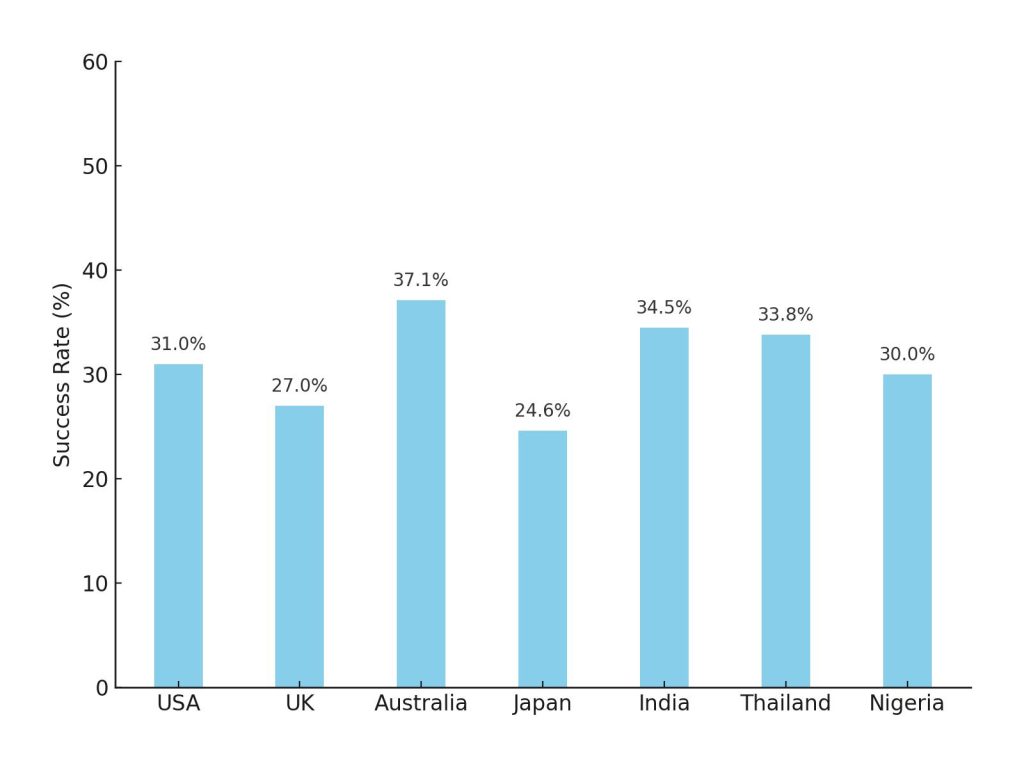IVF success isn’t the same everywhere. Your chances of bringing home a baby could be 20% or close to 60%, depending upon where you get the treatment. If you’re planning to go overseas for IVF, just looking at cost or convenience isn’t enough—you’ll have to evaluate different locations for the highest and lowest success rates.
Below, we compare the average IVF success rates across key fertility destinations, using official reports.

IVF success rates by country (based on verified sources)
Based on the latest data, below are the average success rates per cycle of IVF in different countries.
| Country | IVF Success Rate (Average) | Source |
|---|---|---|
| USA | ~31% live birth rate per embryo transfer (all ages) | CDC ART Report |
| UK | ~27% live birth rate per embryo transferred (all ages) | NHS IVF Guide |
| Australia | ~30.4% per cycle; ~40.6% after 2 cycles | ANZARD Report |
| Japan | ~24.6% per embryo transfer (IVF only) | PMC – ART in Japan |
| India | ~33–36% per embryo transfer | PMC – ART in India |
| Thailand | ~33.8% per transfer | PubMed – Thai ART |
| Nigeria | ~30% clinical pregnancy rate | BMC – Nigerian ART Study |
| Egypt | ~20% pregnancy rate | PubMed – IVF in Egypt |
| Europe | ~34.6% cumulative success rates across different countries | ESHRE report |
Why do IVF success rates vary between countries?
Even though the biological process is the same, IVF outcomes differ due to several structural and regulatory factors.
1. National data reporting standards
A few countries like the US, UK, Australia have official agencies (CDC, HFEA, ANZARD) that track and publish official success rates, but most countries lack centralized data, making it hard to validate performance claims.
2. Lab quality and embryology protocols
High-performing IVF programs consistently:
- Have a qualified team of embryologists and lab techs
- Maintain sterile, tightly controlled lab environments
- Culture embryos to blastocyst stage (day 5)
- Use time-lapse monitoring for embryo selection
If the lab technology is outdated or loosely regulated, outcomes tend to suffer.
3. Investment in research
Investment in research helps doctors better understand the problem and device better solutions.
4. Availability of advanced techniques
Also, the availability of advanced techniques like Pre-implantation genetic testing or PGT can improve IVF success rates. While techniques like ICSI, ERA, PGT are now available in most countries, in places with lower volumes of patients, these are outsourced.
5. The number of good clinics
In many countries there are a few high performing clinics that invest regularly in research and have over four decades of experience. However, the national averages don’t reflect the high-performing clinics.
The most important factor for IVF success variation is experience and capability of the doctor but the accuracy of reporting plays a significant role in the reported numbers too.

What does this mean for you?
Deciding where to undergo IVF can directly affect your chances of success. Consider clinics that:
- Report transparent success rates
- Have advanced lab equipment
- Offer PGT and blastocyst culture
- Have a proven track record with international patients
For example:
- Our top doctors for IVF in Malaysia report 60-80% success in IVF (verified by the RTAC). However, since Malaysia does not have a national report, we do not have any official data on the overall averages and quality of other clinics.
- Similarly, we’ve had >70% success rates for IVF in Mexico (at chosen clinics), but there is no comprehensive data.
- Thailand shows consistent outcomes in published studies, along with excellent service
- India offers relatively high success rates (33–36%) at a fraction of Western costs.
Can affordability and success go hand-in-hand?
Yes—if you choose the clinic carefully. The few countries that have reports on national averages of IVF success are also the ones with the highest cost of IVF.
However, selected clinics in countries like Thailand regularly beat those numbers.
Malaysia, Thailand, and even some European countries are becoming increasingly attractive due to their experienced doctors, great results, and affordable IVF services.
Conclusion: Let the data guide your IVF journey
Success in IVF can be improved by making an informed decision after considering the available data on success rates, doctors, infrastructure, and then choosing the right clinic. While some countries have better resources and regulation, there are excellent clinics in affordable locations too.
By comparing IVF outcomes from trusted sources, you can confidently decide where your best chances lie.